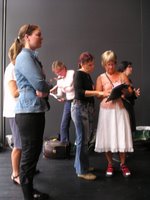 Sorry for the gap in reporting on the Creating Knowledge IV conference - it got rather hectic and then I felt I needed a bit of a rest (also there seems to be a bit of a lack of internet cafes in Copenhagen - I wonder why?). I need to go back now to Thursday, which was the second day of the conference. Interaction and activity was a big feature. The day started with a paper presentation session (which I'll report on separately) but then there was a workshop where we all had to gather in a hall. The facilitator told us to move round to get into groups (by country, by length of experience in our current profession, by discipline) and then we had to get in pairs and tell each other our life stories in a minute.
Sorry for the gap in reporting on the Creating Knowledge IV conference - it got rather hectic and then I felt I needed a bit of a rest (also there seems to be a bit of a lack of internet cafes in Copenhagen - I wonder why?). I need to go back now to Thursday, which was the second day of the conference. Interaction and activity was a big feature. The day started with a paper presentation session (which I'll report on separately) but then there was a workshop where we all had to gather in a hall. The facilitator told us to move round to get into groups (by country, by length of experience in our current profession, by discipline) and then we had to get in pairs and tell each other our life stories in a minute.After this we finally got into preallocated small groups of 5 to 7 people in which we were going to do some activities later that day and the next. I was in group 1A and some of my group are pictured above in the hall. We had again some time to introduce each other in pairs. In Group 1A was me, Charotte Werther, Elisabeth Domeij, Linda Fainburg, Lisa Valdimarsdottir, Susanne Mikki and Ulla Nilsson. I think the earlier activities were useful in keeping us active and moving but perhaps I would have liked a little more time on the getting to know your group activity. However I must say that the variety of activity was a big feature of this conference and it made it more interesting and enabled you to get to know more people.
 In the afternoon we had a session where each little group (and with 150 delegates there were about 24 different little groups) had to address a question and then brainstorm ideas in their group and produce a poster. My group had to brainstorm ideas about How can the educational institution and the library/ academic support be more closely connected?. The poster on the right was the final result. Of the ideas we had, we had to focus on one. Perhaps it was cheating but we managed to focus a lot of our ideas around the (one) concept of communication. It is ACTIVE communication, in that librarians have to take the initiative. there is also the idea of participation, e.g. getting librarians onto key boards and committees. Appropriate channels have to be found to communicate in different ways with different people and groups.
In the afternoon we had a session where each little group (and with 150 delegates there were about 24 different little groups) had to address a question and then brainstorm ideas in their group and produce a poster. My group had to brainstorm ideas about How can the educational institution and the library/ academic support be more closely connected?. The poster on the right was the final result. Of the ideas we had, we had to focus on one. Perhaps it was cheating but we managed to focus a lot of our ideas around the (one) concept of communication. It is ACTIVE communication, in that librarians have to take the initiative. there is also the idea of participation, e.g. getting librarians onto key boards and committees. Appropriate channels have to be found to communicate in different ways with different people and groups.The next stage was that all the groups pinned up their posters in the main lecture room. There was a presenter for each group (me for my group) and the presenter stayed with the poster and presented it while the other groups moved round in a coordinated fashion to have posters presented. Thus (except for presenters!) everyone got to hear about other people's posters. In fact I got to hear a little too, as the visiters discussed the poster. The item in green on our poster ("Students") was actually put in after the first group had visited, because my group had talked about students but not put them in separately! Interestingly, students seem to have more representation and power (if they choose) on committees in some Nordic countries than they generally do in the UK.
No comments:
Post a Comment